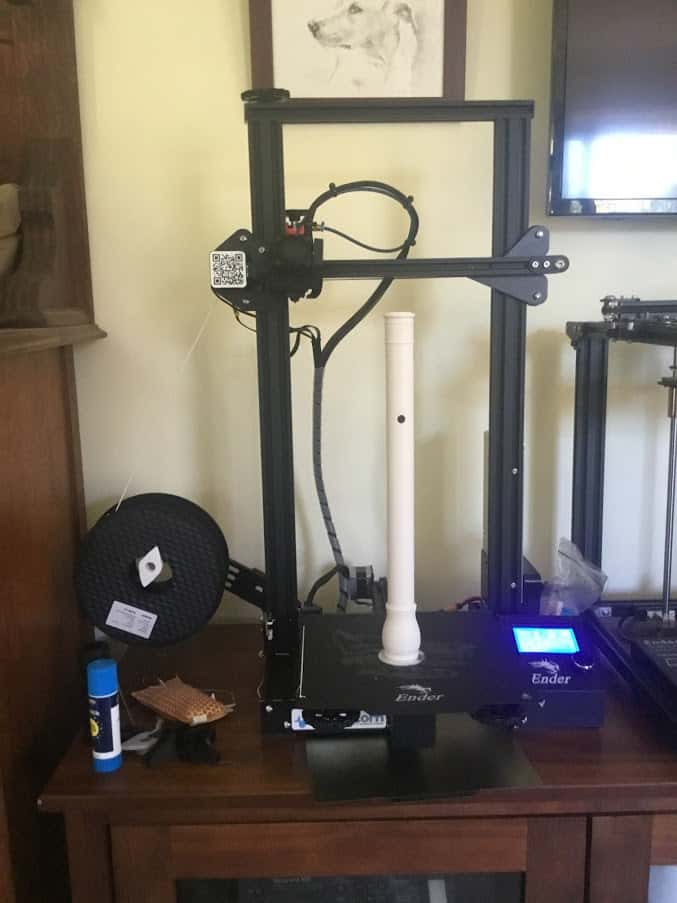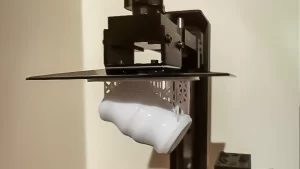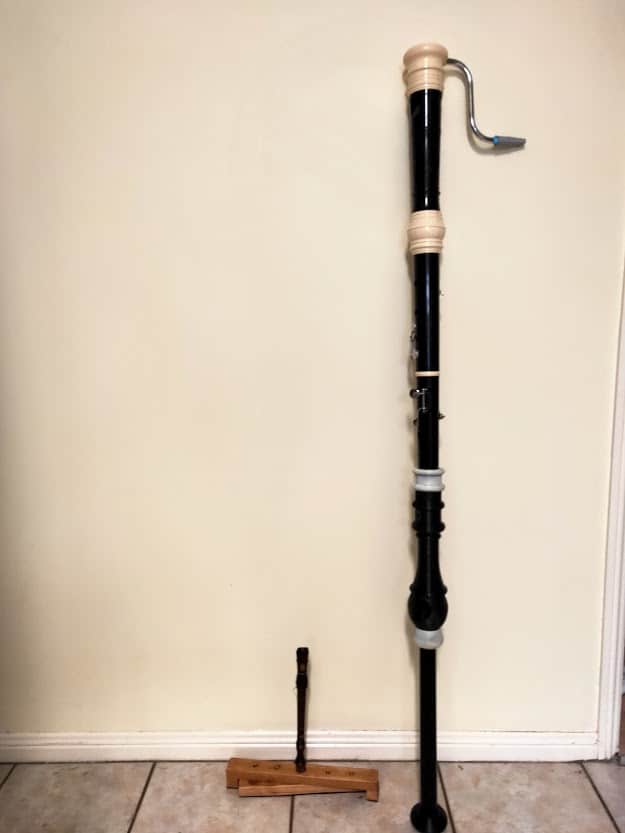The Art of 3D printing musical Instruments that sound & play as if they were the handcrafted original.

“It became apparent that it’s possible to recreate the complex bore shapes using 3d printing without needing specialist shaped reamers for each different instrument.”
Customer Spotlight: David’s Journey from Traditional Craft to 3D Resin Printing
David has been a valued customer of Monocure3D for some time. One day, during a friendly chat with him over the phone, I asked one of my favourite questions: “What do you create with your 3D printer and our consumables?” This question often yields surprising and inspiring responses, and David’s answer was no exception.
He revealed that he was replicating traditional woodwind instruments and bringing them to life through 3D printing. Intrigued, I arranged to sit down with David to learn more about his journey, process, and experience. Here’s what he shared about his craft and his transition into the world of resin printing.
From Tradition to Innovation
David’s passion for instrument-making began decades ago. He recalled:
“I took a woodwind repair course at Merton College in London around 1989. I still have most of the first set of pipes I made from plans—Bruegel Pipes in D. After that, I delved into repairing, restoring, and conserving old woodwinds, particularly early flutes, for several dealers across southeast England. Eventually, I acquired my lathe and began crafting instruments, primarily bagpipes—though not the Highland kind! And no, I don’t play ‘Amazing Grace!’”
In early 1994, David relocated to Queensland, Australia, bringing all his tools with him. He continued his craft while working various jobs and became an active Australian Association of Instrument Makers member for many years.
2. Please explain the traditional methods that you used to make them.
“Traditional methods for woodwinds are pretty simple: get a bit of wood and make a hole down the middle.. then put some holes in one or both sides and some way to blow into it; in the case of flutes, it is another hole in it or bagpipes and oboes they need a reed. Making straight holes is easy; it’s just a drill, but when it needs to be conical, you must make reamers to follow the required profile. Flutes and recorders use large holes, but oboes and pipes are very narrow, so the choice of timber is important, it needs to be straight close-grained.”
3. How long, on average, would it take to make an instrument from start to finish when doing it traditionally?
“Putting a hole through the middle of a bit of wood can be catastrophic, so I tend to cut the blanks to near the length required and drill a pilot hole through of about 4 mm, depending on the final bore. I will leave it like that for at least two or three months to ensure the wood isn’t going to fail. Then I will bore the interior, using a wood lathe, steadies and reamers, if it still stays in one piece.. the outside is turned to approx size, and tone holes are measured and drilled. Outside decorative rings also turn in a contrasting material, strengthening the sockets where the joints join.”
4. When/how did you discover 3D printing would be a suitable technology for replacing the traditional methods?
“I have known about 3d printing for a long time through a friend at the National Physical Laboratory in the UK; he was working with French ethnomusicologists to 3d print some ancient instruments using SLP methods in the early 2000s. In 2018 I became involved in another musical instrument project a laser cut and 3d printed Hurdy Gurdy, The Nerdy Gurdy, developed by a Dutch engineer to make a playable instrument more affordable. I ended up beta testing the kits, I then got my first Aldi 3d printer! It became apparent that it’s possible to recreate the complex bore shapes using 3d printing without the need for specialist shaped reamers for each different instrument. So much so I have made instruments no one else has bothered to before.. and possibly some of the originals haven’t been played in almost 400 years. So to reproduce affordable and accessible replicas of these important instruments became my plan.”
“To turn a wooden flute, there is about 85% wastage […], and even with failed prints, it uses far fewer raw materials.”
5. How does the time & cost compare when 3D printing to the traditional methods?
“To turn a wooden flute, there is about 85% wastage. Time-wise, it certainly takes less time to turn down a bit of wood on a lathe than to print it, but even with failed prints, it uses far fewer raw materials.”
6. What materials do you use?
“For the wooden instruments, since I first started in the late ’80s, I ensure I know where every bit of wood I use comes from. In Australia, we have some of the best timbers in the world. There is no shortage of amazing offcuts. As for printing, I use PLA for the instrument bodies, for the ornamental rings I’ve found white resin looks amazing.”
7. Without telling us all your secrets, please run us through some of the processes from start to finish.
“I need suitable dimensions to create the 3cad and STL files. Instruments have been made available in museums around the world. These plans are very well detailed and often have information on how the original instruments play, sound and how they are tuned. I redraw them into 3cad and then export the individual bodies and parts to STL. For a four-joint instrument, I only print one bit at a time; it doesn’t take much more time, and that way, if something goes wrong, only one part needs reprinting. After printing, there can be a lot of tuning and adjusting.
8. What 3D printers do you currently have, and which is your favourite?
“My workhorses are an Ender 5 pro and Ender 3pro with an extender to print up to 500 mm high for filament and a Creality 002R resin printer.”
9. How do you finish the instruments? Do you paint, stain or varnish them?
“I only use white or light grey PLA. Lately, I’ve converted to Monocure3D Matte White PRO+ and the white Tensile resin for the rings. I sand the outsides, then use wood stain, and we’ve started sealing it with traditional shellac or French polish. The rings on the layers make it look as if it’s turned …
“if you tell someone “it’s 3d printed,” there are preconceptions, so it best just to play them.”
10. How do the 3D-printed instruments compare to the sound quality of the traditional ones?
“This is where things get a bit complicated if you tell someone “it’s 3d printed” there are preconceptions, so best just to play them, or better still let other musicians play them! There is a massive community worldwide where we collaborate on one’s ideas and concepts, many of these are at music schools around the world and studying at the highest levels. Their musical and ethnomusicology credentials are spread very wide. It is often those not so good at something that will demean what they consider inferior.”
11. Have they ever been used for a live performance? If so, please tell us more!
“Yes, quite recently, I’ve been collaborating with an incredible locally based flautist and maker. We’ve made/printed four replica early flutes. He played one for two of his three pieces at a baroque music concert here in Brisbane. The other musicians knew, and at first, they were sceptical but soon realised these were perfect instruments. While he mentioned in an introduction that he’d been working with me and was excited to play such outstanding instruments, he didn’t say it was printed plastic! It was a very emotional experience. Many of the instruments such as the replica recorder bodies do not play in a pitch that anyone else does, I have gained a bit of a following among makers worldwide, most were sceptical at first but now can see we can replicate details that are almost impossible using traditional methods…”
“Most were sceptical at first, but now we can see we can replicate almost impossible details using traditional methods.”
12. How many different types of instruments have you 3d printed? Please name some.
“There are a lot of recorder bodies, around 20 different ones, all based on original 17 and 18C instruments. The Sub bass Racket.. its bore goes back and forth, if it was not folded it would be about 2m long! The flutes, 4 different models, but several versions of each one. Just now working on a copy of an early 18th C oboe, made two, one is somewhat ready to go, the other is not even fitted together yet… I am also fascinated by an instrument called a musette du cour, it is perhaps the most complex form of bagpipe ever made and was popular in France in the royal court in the 17th C, a lot of music was written for it, and there are only perhaps 4 makers still producing them today… I have an ongoing project in trying to produce an affordable version… I’ve printed a few different ones, but yet to get one working with its keys let alone set up with the 6 to 8 reeds it needs! Work in progress, you could say.”
13. Do you sell 3D-printed instruments?
“Only if someone is aware of what they are getting, but as a rule, happy to loan them out to be played but not interested in selling them.”
“Anyone can make something look pretty, but if a musical instrument doesn’t work, it’s a waste of materials.”
14. What advice would you give someone who wanted to follow in your footsteps and start printing musical instruments?
“I’ve given talks and lectures in the past to woodturners clubs, and I’ve always said the same thing. Anyone can make something look pretty, but if a musical instrument doesn’t work, it’s a waste of materials. It takes much more than putting a file in a printer …..it’s been a massive ongoing learning cycle.”


